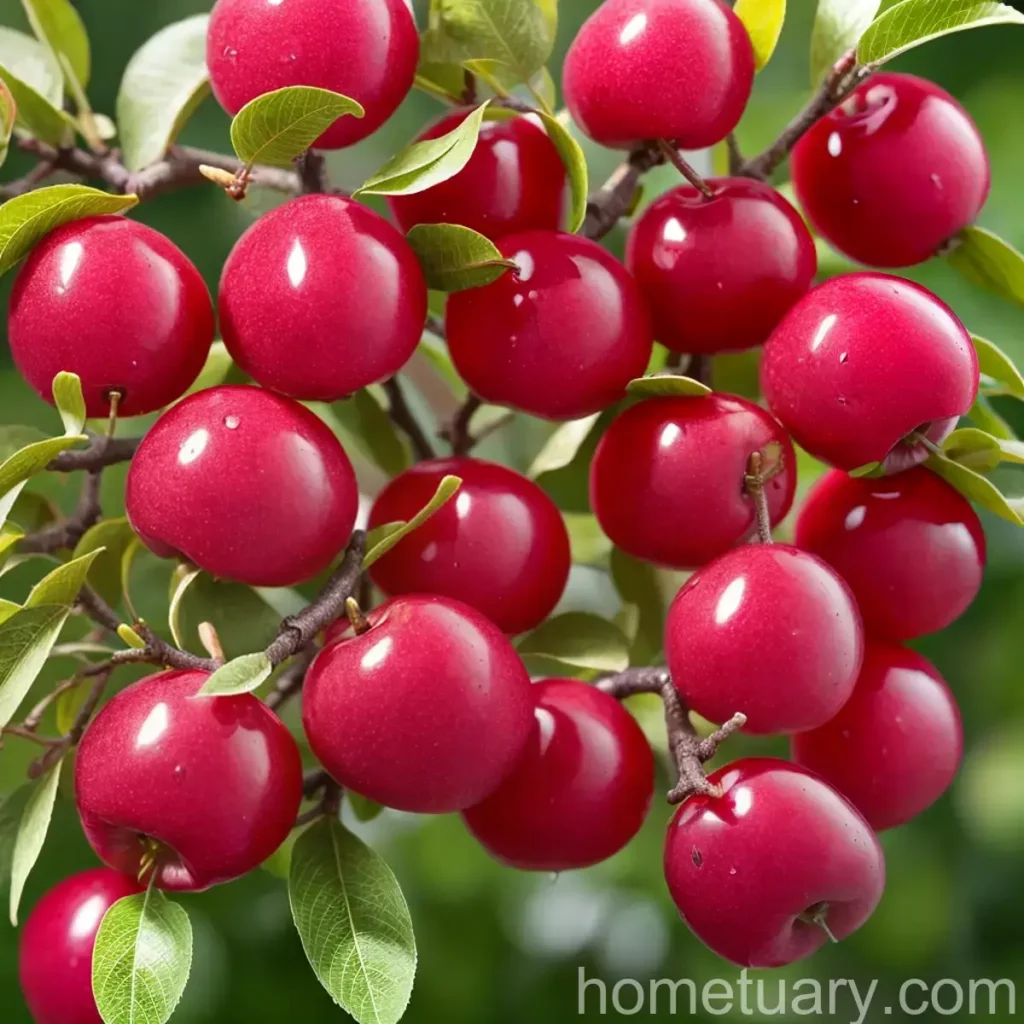Malus Ruby Tears� (Crabapple) – A Complete Plant Care Guide
In the world of ornamental trees, the Malus Ruby Tears�, commonly known as Crabapple, shines as a beautiful and versatile addition to any landscape. With its stunning blossoms, colorful fruits, and resilience against various environmental conditions, the Ruby Tears Crabapple represents an excellent choice for both novice and experienced gardeners. In this comprehensive guide, we will delve into the fascinating world of Malus Ruby Tears�, covering its care, uses, common diseases, and much more.
What is Malus Ruby Tears� (Crabapple)?
The Malus Ruby Tears�, a variety of Crabapple, is a deciduous tree that belongs to the Rosaceae family. Its botanical name, Malus, encompasses a diverse group of trees, including many known for their fruits and ornamental blossoms. The Ruby Tears Crabapple, specifically, is renowned for its weeping habit, creating a graceful and elegant appearance. Its delicate foliage, vibrant blooms, and petite fruits make it a captivating choice for homeowners and landscape designers.
Key Takeaways – Malus Ruby Tears� (Crabapple)
Before getting into the specifics, let’s take a quick look at the key takeaways for Malus Ruby Tears�, focusing on its culture, uses, and essential care requirements.
Culture
- Water: Regular watering, especially during the initial establishment phase, with a preference for well-drained soil.
- Sunlight: Full to partial sunlight, ensuring adequate light exposure for healthy growth and abundant blossoms.
- Fertilizer: Annual fertilization in early spring, utilizing a balanced formula to support overall tree health.
- Soil: Well-drained, slightly acidic soil with good fertility and aeration.
Uses
- Ornamental: Ideal as an ornamental tree, adding beauty and visual interest to landscapes.
- Wildlife Attraction: Attracts birds and wildlife due to its colorful fruits and dense foliage.
Let’s dive deeper into these key aspects to understand the complete care requirements and unique characteristics of the Malus Ruby Tears�.
Malus Ruby Tears� (Crabapple) Care Guide
Water
Proper watering is essential for the health and vitality of Malus Ruby Tears�. During its initial establishment, regular watering is crucial to support root development and overall growth. Once established, the tree generally exhibits good drought tolerance, yet it’s important to monitor soil moisture levels, particularly during dry periods.
- Watering Frequency: Water deeply and regularly, ensuring the soil remains consistently moist but not waterlogged.
- Establishment Phase: Pay special attention to watering during the first few growing seasons to encourage robust root system development.
Sunlight
Malus Ruby Tears� thrives in full sunlight, although it can tolerate partial shade. Adequate sunlight exposure is instrumental in promoting prolific blooms and healthy foliage.
- Sun Exposure: Optimal growth occurs in full sunlight, providing at least 6 hours of direct sunlight daily.
- Shade Tolerance: While it prefers full sun, it can tolerate partial shade, especially in regions with intense afternoon sun.
Fertilizer
Annual fertilization is beneficial for Malus Ruby Tears�, supplying essential nutrients for robust growth and flowering. A balanced fertilizer is recommended to support overall tree health and vigor.
- Fertilizer Type: Apply a balanced, slow-release fertilizer in early spring before new growth emerges.
- Application Method: Spread the fertilizer evenly over the root zone, avoiding direct contact with the trunk.
Soil
The right soil conditions are crucial for the successful cultivation of Malus Ruby Tears�. Well-drained, slightly acidic soil with good fertility and aeration is ideal for ensuring the tree’s health and longevity.
- Soil Type: Well-drained, loamy soil with a slightly acidic to neutral pH range (pH 6.0-7.0).
- Soil Amendments: Incorporate organic matter into the soil during planting to improve its structure and fertility.
Pruning
Pruning is an essential aspect of Malus Ruby Tears� maintenance, contributing to its overall health, shape, and aesthetic appeal. Proper pruning practices help in maintaining a balanced form and promoting bountiful blossoms.
- Pruning Time: Conduct routine pruning during the dormant season in late winter to early spring.
- Pruning Objectives: Remove dead or diseased branches, shape the tree, and thin out crowded growth to enhance air circulation.
Propagation
The propagation of Malus Ruby Tears� can be achieved through various methods, including grafting and seed propagation. For home gardeners and enthusiasts, grafting is a popular and reliable technique to propagate true-to-type specimens.
- Grafting: Utilize grafting techniques to propagate specific cultivars and maintain desired traits.
Container Growing
While Malus Ruby Tears� is typically grown in the ground, it can also thrive in containers under the right conditions. Container cultivation offers versatility for urban gardens, patios, and small outdoor spaces.
- Container Size: Choose a large container with adequate drainage holes to accommodate the tree’s root system and provide stability.
- Care Considerations: Monitor soil moisture levels closely and provide regular fertilization as container-grown trees are more reliant on external inputs.
Utilization and Popularity
Ornamental Beauty
The most significant utilization of Malus Ruby Tears� lies in its ornamental value. Its graceful weeping habit, vibrant blossoms, and colorful fruits make it an attractive choice for landscaping and adding visual interest to outdoor spaces.
Wildlife Attraction
Beyond its visual appeal, Malus Ruby Tears� also serves as a valuable resource for wildlife, attracting birds with its fruits and providing shelter within its dense foliage.
Common Diseases
Disease Diagnosis
Malus Ruby Tears�, like other crabapples, can be susceptible to certain diseases. Understanding and promptly addressing potential diseases is crucial for maintaining the tree’s health and preventing widespread issues.
- Common Diseases: Keep an eye out for common diseases such as apple scab, powdery mildew, and fire blight.
- Symptom Recognition: Learn to recognize symptoms of common diseases to facilitate early intervention and management.
Common Pests
Pest infestations can also pose a threat to the health and vigor of Malus Ruby Tears�. Regular monitoring and proactive pest management practices are vital for keeping pest populations in check.
- Pest Identification: Familiarize yourself with common pests such as aphids, caterpillars, and mites that can affect crabapples.
- Integrated Pest Management: Incorporate cultural, biological, and, if necessary, targeted chemical controls to manage pest issues effectively.
Botanist’s Tips
Careful Monitoring
Regular observation and monitoring of Malus Ruby Tears� are essential for identifying any signs of stress, diseases, or pest infestations. Early intervention can significantly impact the tree’s long-term health and vitality.
Tailored Pruning
Approach pruning with specific objectives in mind, such as shaping the canopy, removing dead or diseased wood, and enhancing air circulation within the tree. Tailored pruning practices contribute to the tree’s overall well-being and visual appeal.
Fun Facts about Malus Ruby Tears� (Crabapple)
- Malus Ruby Tears� is a weeping variety of crabapple, featuring cascading branches and a graceful form.
- The tree produces small, cherry-sized fruits that can range in color from red to yellow, providing ornamental value and attracting wildlife.
- Its abundant spring blossoms showcase hues of deep pink to red, creating a stunning display in the landscape.
- While commonly grown in traditional landscapes, Malus Ruby Tears� is also suitable for container gardening, adding versatility to its usage.
Links to External Resources
For further exploration of Malus Ruby Tears� care, cultivation, and ornamental value, the following external resources offer valuable information and insights:















